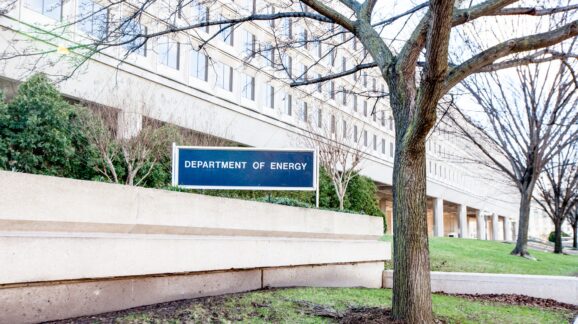DOE’s Press Release on Federal Building Energy Standards Is Inaccurate, Misleading, and Unserious

Photo Credit: Getty
The Department of Energy (DOE) last week released the pre-publication version of a proposed rule to “establish energy performance standards for the construction of new federal buildings, including commercial buildings, multi-family high-rise residential buildings, and low-rise residential buildings.” DOE’s press release boasts that its “first ever” greenhouse gas (GHG) emission standards for new federal buildings will “save $8 million per year in costs and decrease long-term carbon emissions.” From the release:
Buildings are a major source of greenhouse gas emissions in the U.S., and fossil fuels used in federal buildings account for over 25% of all federal emissions. If enacted within the proposed timeframe, DOE estimates that the new emission reductions requirements would save taxpayers $8 million annually in upfront equipment costs. Over the next 30 years, the new rule would reduce carbon emissions from federal buildings by 1.86 million metric tons and methane emissions by 22.8 thousand tons—an amount roughly equivalent to the emissions generated by nearly 300,000 homes in one year.
The foregoing verbiage is inaccurate, misleading, and unserious. For starters, the proposed energy consumption-reduction standards are “first ever” only in the sense that they are now also calculated in tons of carbon dioxide-equivalent (CO2e) emissions per square foot—not only in thousands of Btu per square foot, as in previous DOE rules.
Section 433 of the 2007 Energy Independence and Security Act (EISA) requires DOE to adopt rules ensuring that federal buildings constructed or renovated during 2010-2030 meet the following fossil-energy reduction targets compared to similar buildings in 2003:

New federal buildings are already required to consume zero Btus of fossil-fuel energy by 2030. What is “first ever” in the proposed rule is a change in nomenclature. Presumably, using CO2e per square foot as a benchmark for compliance is intended to the give President Biden another climate change bragging right.
According to the press release, over the next 30 years, the proposed rule will reduce CO2 emissions from federal buildings by 1.86 million metric tons. What impact would that have on global warming? The U.S. government uses the Model for the Assessment of Greenhouse Gas Induced Climate Change (MAGICC) to calculate the temperature effects of various emission scenarios and mitigation policies. Users can run MAGICC with different estimates of how much long-term warming results from a doubling of atmospheric CO2e concentration—a value known as equilibrium climate sensitivity (ECS).
Here is a reasonable back-of-the-envelope calculation:
- US annual GHG emissions (CO2e): 6.6 billion tons (2019)
- Assume constant emissions for 30 years: 6.6 x 30 = 198 billion tons
- 1.86 million/198 billion = 0.0000094, or 0.00094 percent
- Assume an ECS of 3 degrees Celsius: MAGICC projects a temperature reduction in 2100 of 0.00001°C
For perspective, the National Oceanic and Atmospheric Administration’s (NOAA) margin of error for measuring changes in global annual average temperature is 0.08°C. The climate mitigation achieved by the proposed standards is orders of magnitude smaller than the margin of error. The rule’s mitigation effects are way too tiny to be detected, measured, or verified.
Actually, the proposed standards will avert even less than 0.0001°C of warming. The proposed rule itself nowhere says the standards will avert 1.86 million metric tons (MMT) of “carbon emissions.” Rather, the proposal projects CO2 emissions to increase by 0.2 million tons over the 30-year period, as federal buildings become increasingly reliant on grid-based power for HVAC systems, hot water systems, cooking systems, or other systems or components currently powered by natural gas, diesel, or other on-site fossil fuels.
The proposal also estimates the standards will reduce methane (CH4) emissions by 10.4 thousand tons, not 28.8 thousand tons, as the press release has it.

According to the proposal, combining the CO2 increases with the methane savings and minor increases in nitrogen oxide (N2O) “results in an overall net savings of CO2e emissions of approximately 0.07 MMT (million metric tons) CO2e” (p. 112). That figure is 26.5 times smaller than 1.86 MMT. Accordingly, the climate mitigation should be many times smaller than 0.00001°C.
Now for the misleading part. According to the press release, “the new emission reductions requirements would save taxpayers $8 million annually in upfront equipment costs.” Okay, but what about operating costs? Gas heaters and appliances are often cheaper to run than their electric counterparts. Here’s what the proposal says about the standards’ impacts on capital and operating costs (p. 121):
- “Capital cost impacts of the standards proposed in this case are estimated to be $7.89 million per year in decreased equipment costs.”
- “Annual operating disbenefits are estimated to be $8.26 million per year in increased equipment operating costs, primarily driven by the higher relative cost of electricity compared to natural gas.”
On balance, the proposed standards impose an annual net cost on taxpayers of $370,000. That is peanuts in the scheme of things, to be sure. Congress’ party-line enactment of the Inflation Reduction Act may increase federal climate-related spending and tax credits by between $369 billion and $800 billion and authorize up to $350 billion in new DOE loans. Whatever else the Biden administration may be doing in the name of climate change, it is not looking out for taxpayers.
To sum up, the new standards are required by a longstanding statute, so even if the required fossil-fuel reductions were a good idea, DOE deserves no credit for them. Converting the standards from kBtus into tons CO2e is an advertising gimmick. The standards will do squat for climate change mitigation. The proposal is not taxpayer friendly, and even if the standards reduced net taxpayers’ costs by $8 million annually, saluting the Biden administration’s climate agenda as pro-taxpayer makes no sense.